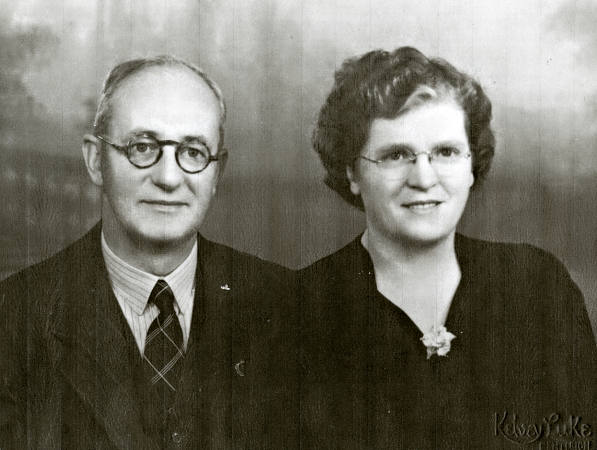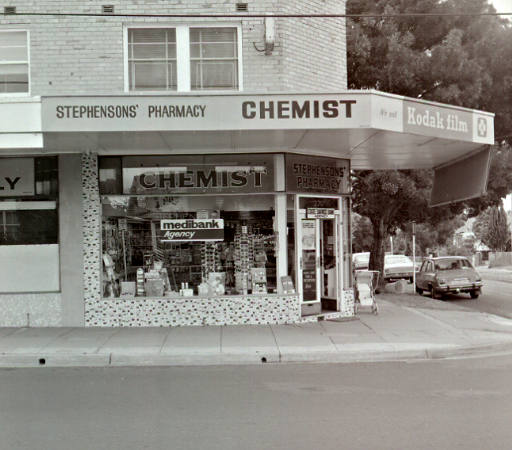Dr Keith Arnold Stephenson: Cheltenham Doctor

Dr Keith Stephenson with his wife Florence, c1940. Courtesy Eric Longmuir.
Keith Arnold Stephenson was born in Geelong on 4 December 1894 to Robert and Elizabeth Mary (Podbury) Stephenson. His father was a primary school teacher. After completing his secondary education Keith attended Melbourne University where he studied medicine. During the time at University he joined the Melbourne University Rifles as a signaller, serving there for four years. (The Rifles were formed in 1910 to provide military training for undergraduates.) On graduation he took up a position as a medical officer at the Infectious Diseases Hospital at Fairfield and in March 1918 he applied for a commission in the Australian Army Medical Corps. Commissioned as a captain he was assigned to the Base Hospital in Melbourne.
On June 1, 1918 he and Florence Mabel Hurley were married in the Methodist Church in Lydiard Street, Ballarat. At the time his parents were living at 52 Webster Street, Ballarat. Both Keith and Florence were 23 years of age and both their fathers were Primary School Inspectors in the Education Department of Victoria. Ten weeks after his marriage Captain Stephenson embarked from Sydney on HMAT Port Sydney for Suez. Stationed at the military base at Moascar he served as a doctor assisting the wounded and sick soldiers. He himself became ill with dysentery and for a time became a patient in the hospital. When Captain Stephenson arrived in Egypt on September 19, 1918 the conflict with Germany and her allies was almost over so it was only a matter of months before he, together with other members of the Australian contingent, sailed from Egypt for Australia on the transport HT Dongola. It was on 17 October 1919 that he was gazetted from the Australian Imperial Force.
After service in the army Dr Keith Stephenson went into practice in the country, serving for years in the Wimmera town of Natimuk. Later, in 1938, when his four children were ready for secondary education, he bought the medical practice in Cheltenham from Dr Birrell. After graduating from Melbourne High School his elder son Donald Keith entered Melbourne University, but after one year he joined the RAAF on 20 September 1941. Unfortunately, he lost his life near New Guinea in 1944. His elder daughter, Lois Minna, graduated from MacRobertson Girls’High School and became a nurse. She joined the WAAF and while nursing at Heidelberg Repatriation Hospital met her future husband, Guy Hopkins. Together they had five children and lived in Sydney. Dr Stephenson’s younger daughter, Dorothy also graduated from MacRobertson Girls’ High School. She became a pharmacist, married Peter Day, and had three children. She also lived in Sydney. His younger son Robert Hurley Stephenson, graduated from Wesley College and also became a pharmacist, as was his wife, Barbara, nee Brown. He had a pharmacy business in Highett from the time of his marriage in 1951 until 1983. He had four children and died in 1996.

Stephenson’s Pharmacy in Highett Road, Highett, 1976. Courtesy Leader Collection.
The family home was a stately bluestone building situated on a large, treed site on the corner of Charman Road and Glebe Avenue, extending to the lane adjacent to the Cheltenham Primary school. It contained an extensive orchard, mature deciduous trees and a well maintained lawn tennis court at the rear of the property.
Always a patient, and compassionate man, Dr Stephenson worked tirelessly in Cheltenham and was also the Municipality Medical Officer. In 1941 my widowed mother, while in the city, was hit by a tram resulting in a stay of several weeks in the Melbourne Hospital. Dr Stephenson and Mrs Stephenson at their Cheltenham home took both myself and my brother in, caring for us until our mother was fit enough to return home and take up the responsibilities of caring for her family. This was just one instance of Dr Stephenson’s and his wife’s willingness to put into practice strongly held Christian principles.
The Typhoid Epidemic, which occurred during the time of World War Two resulted in extremely heavy work loads for the only two GPs for Cheltenham, Highett, Beaumaris and Heatherton districts, namely Dr Stephenson and Dr Hudson. This writer can recall waiting at night time in the living room of Dr Stephenson’s residence for immunisation with many others, as the surgery waiting room was over-crowded. The culmination of overwork which the Typhoid Epidemic of 1943 brought, plus the sad loss of his son Donald, led to a severe heart attack and he retired from the practice in 1947, leaving Dr Robert Buntine to carry on the work.
Dr Stephenson was a regular worshipper at the Cheltenham Methodist Church, later to become the Charman Uniting church. He was a member of the church choir and was known to have written the words for choir anthems, with the music provided by the then choir master and friend Mr John S Campbell senior. He was a lover of literature which included the Bible and works of Robert Browning. In 1954 when the Cheltenham Methodist Church was about to celebrate its centenary Dr Stephenson wrote a history of the church from its beginning on the veranda of Stephen Charman’s cottage in Beaumaris to its establishment on its present site in Charman Road. The souvenir program reflected Stephenson’s careful research and effort in naming individuals who played key roles in its growth.
Despite two further heart attacks he worked as a Medical Officer at the Repatriation Department until he retired. He died at his home at 121 Wickham Road Moorabbin in 1965, aged 70 years.
